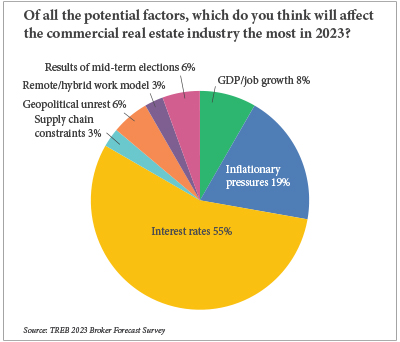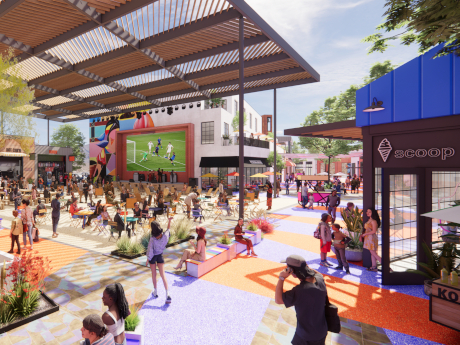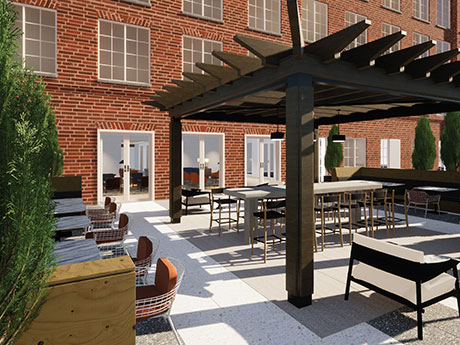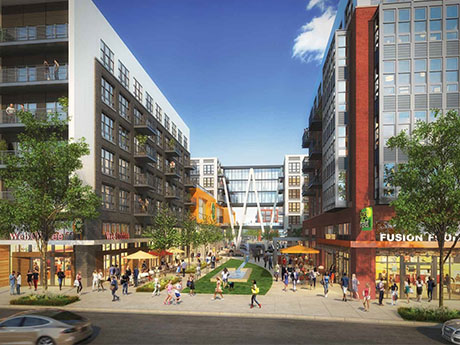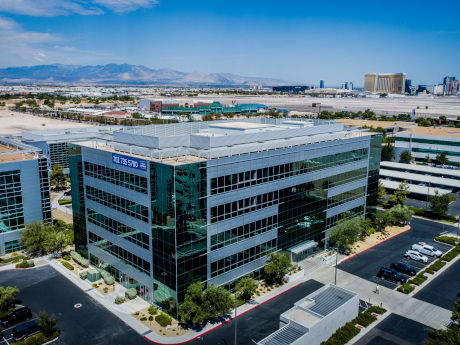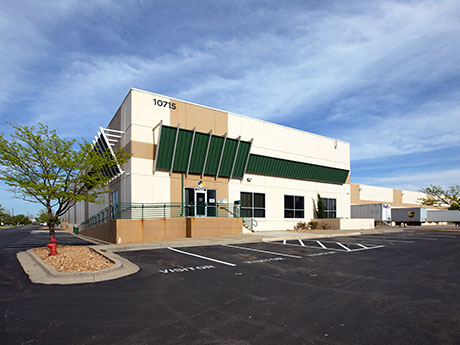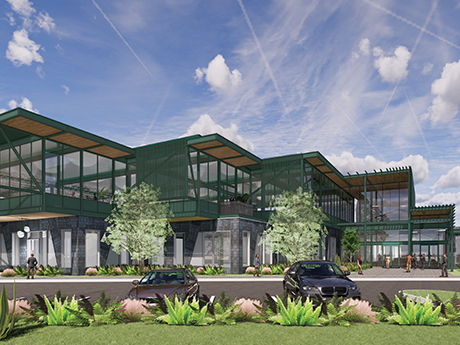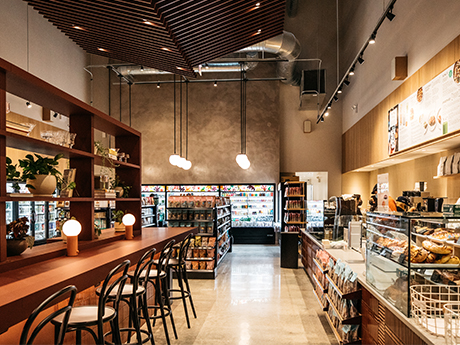By Taylor Williams If inflation was the story of 2022, then basic economic theory dictates that interest rate hikes and their subsequent impacts will be the featured issue of 2023. For when it comes to whipping inflation, the Federal Reserve only has so many tools in its kit. The nation’s central bank can raise reserve requirements for lenders and sell Treasury notes all day long, but nothing has as direct and powerful of an effect on the monetary supply as movement in short-term interest rates. Simply put, higher interest rates discourage borrowing activity, which reduces the amount of money circulating in the system. In the past 12 months, the U.S. economy has seen no fewer than seven rate hikes totaling 425 basis points, with the Fed indicating that more increases are on the docket for 2023. Much like severe inflation itself, the rate hikes that inevitably follow rampant price escalation tend to touch nearly every facet of commercial real estate. Developers and investors respectively face higher interest rates on construction and acquisition loans. Brokers must adjust prices on properties they’re listing for sale or rent in response to these variables. End users tend to be somewhat insulated from these impacts, …
Market Reports
By Cathy Jones, Founder and CEO, Sun Commercial The 2022 Las Vegas retail market can be characterized by a generally positive outlook and some strong trends, even in the face of market uncertainty. A few of these core trends are quite interesting. Market research shows significant upward trends in asking rents, decreases in vacancy and certain key indicators driving this process. When broken down further, we find that these trends are emphasized in certain geographic areas more than others. The Southwest Las Vegas Valley submarket is seeing the greatest change in growth and development, followed closely by Henderson/Southeast. As an example, 93,592 square feet of retail space was constructed in the third quarter alone in the Southwest and Henderson; 91.2 percent of this space was pre-leased. The current amount of net absorption in the total market is 1.3 million square feet year to date. Half of this annual total occurred in the Southwest and Southeast submarkets. These two markets saw an explosion of growth driven largely by the housing boom. As new developments are constructed and homes sold, retail developments expand to meet that growing demand. There is more compartmentalization, however, than in the past with more community-oriented unanchored strip centers dominating the …
By Artie Kerckhoff and Joshua Allen, CBRE For businesses, the conversation around the return to office has shifted. Most companies find themselves considering how to entice workers back instead of when to call them back. It’s an interesting dynamic, born out of stopgap remote-working policies and catalyzed by an employee’s market. Where does this leave the St. Louis office market? The metro’s overall office vacancy rate remained steady at 12.9 percent at the end of the third quarter. Yet, leasing velocity has shown significant improvement with leases signed at newly constructed buildings like Forsyth Pointe & Commerce Tower in Clayton and Edge@West in Creve Coeur. In addition, a handful of tenants have signed new leases at existing prime Class A, amenity-rich buildings such as Centene Plaza C Building, The Plaza in Clayton and Shaw Park Plaza. The reason for this uptick is a trend that’s playing out in St. Louis and across the country: an overall flight to quality. Prime at a premium At the onset of the pandemic, office users signed short-term extensions and took a wait-and-see approach to get through the immediate crisis. Now, as those extensions expire, they’re migrating to prime Class A office space with collaborative, …
By David Ebro, president of Levey Group Despite the nearly 6.4 million square feet of new project starts during the fourth quarter of 2022, which grew the volume of Houston’s industrial space currently under construction to 33.5 million square feet, the market posted a record 30.3 million square feet of net absorption for the year. This activity drove Houston’s vacancy rate down to 3.8 percent — a decline of 220 basis points from the end of 2021. The remarkable growth throughout the Houston MSA — the nation’s fourth-largest metropolitan area — has developers racing to find buildable sites both within and beyond the city limits. As a result, industrial development is bulging out of the city and into submarkets such as Baytown, Richmond and Brookshire as developers pursue more economically feasible land among these growing population centers. Beyond favorable land opportunities, Houston’s outlying submarkets offer the workforces that tenants require for their warehouse and distribution operations. These growing submarkets are also generating an increasing amount of demand from e-commerce users in the consumer goods sector. Record Growth East of Houston Much of the industrial growth can be found east of town, near and along the Houston Ship Channel. For the …
Across the country, investors are facing some difficult hurdles. Rising interest rates, impending economic recession and rising construction costs are making it increasingly difficult for proposed deals to penicl out for investors. These issues, coupled with a swath of non-performing loans that are nearing maturity, have been the first indications we have seen of a bear market in the real estate world, and there are no signs of improvement in the near future. In times of uncertainty, we often see investors adhere to a conservative approach to investment, which normally means increased focus on core markets and assets. One area of focus in which investors have remained bullish is Washington, D.C.’s multifamily market as it continues to thrive, despite turmoil in the larger U.S. economy. Developers broke ground on new multifamily product in excess of 4,000 units for the fourth consecutive quarter, a first for the D.C. market. Multifamily sales volume has not quite matched the bull market of 2021; however, sales in 2022 still outpace most years in the metro’s history. Whether it’s construction on ground-up development of multifamily product, or the purchase of existing multifamily product, the D.C market has not shown any signs of slowing down. For …
By Patti Dillon, SIOR, Senior Vice President, Colliers While the key measures of the Southern Nevada economy have improved since the COVID lockdowns, some have improved more than others. The future of the office market is strong, but it will be weighted toward newer Class A mixed-use office assets. Employers are feeling the pressure to attract and retain the best talent in a tight labor market. There are plenty of vacant positions. However, available and willing workers are still scarce, which is driving the need for office locations of employers to be more inviting. According to DETR, Southern Nevada’s office job market added 24,000 jobs between May 2021 and May 2022. Unemployment in the Las Vegas-Paradise MSA was 5.2 percent in May 2022. Over the past 12 months, total employment in Southern Nevada increased by 87,100 jobs, a 3 percent increase. After experiencing a significant expansion last quarter, Southern Nevada’s office market cooled at midyear. Net absorption remained positive, at 45,443 square feet, but did not keep pace with the 129,272 square feet of new development. This lifted vacancy to 12.7 percent this quarter from 12.5 percent one quarter ago. Asking rental rates increased to $2.37 per square foot on a full-service …
By John Hassler, Newmark Zimmer At the close of 2022, Kansas City’s industrial property market hit heights that would have been unimaginable only a decade prior. While Kansas City ranks as the 31st-largest MSA in the United States by population, it is the 16th-largest market nationally based on industrial square footage with nearly 315 million square feet of total inventory. Further, Kansas City ranks 10th nationally in the percentage of annual net absorption as compared with its market size and has added an impressive 62.5 million square feet of newly developed square footage over the last 10 years. Many factors have contributed to the market’s growth trajectory including the nation’s most geo-central location (a two-day truck drive to 85 percent of the continental U.S. population), the confluence of five Class-1 railroads (with four area intermodal centers), the intersection of four of the nation’s busiest interstates (including I-35 and I-70), an available and reasonably priced workforce, an abundance of industrial development sites in pro-development communities, and an experienced, well-capitalized concentration of developers headquartered in the area. Kansas City has leveraged those various logistical and strategic advantages at a perfect time to capitalize on an all-time high in industrial space demand with …
Sustained leasing velocity for industrial/warehouse space in the Northern Virginia market, combined with the nearly insatiable demand for data center product, is contributing to developers repurposing existing business communities with this asset class to support demand, as well as companies expanding their geographic footprints into suburban Maryland and Central Virginia to secure space. This trend could be pivoting slightly due to the recent slowdown in leasing activity both locally and nationally as it relates to rising interest rates, the prospects for a looming recession and the possible end of a prolonged real estate cycle. The vacancy rate for industrial/warehouse space in the region currently stands at just over 2 percent. In the last quarter, the Northern Virginia industrial market experienced the largest pipeline in its history with more than 1 million square feet of space delivered, with nearly 5 million square feet of space in the development pipeline. The largest projects are contained within Stafford County as land in Loudoun and Fairfax counties has become unaffordable, or simply unattainable. Triple-net asking rents reached another all-time high of $12.45 per square foot in the third quarter, aided in part by these new deliveries. New space remains scarce and commands a premium, …
By Taylor Williams From small-scale refreshes of neighborhood shopping centers to massive conversions of regional malls, retail redevelopment has become a budding business as seismic forces like e-commerce and COVID-19 have fundamentally altered the ways in which Americans shop, dine and seek entertainment. Yet empirical and anecdotal evidence shows that people still love to frequent brick-and-mortar stores, restaurants and entertainment centers. According to data from Transwestern, at the end of the third quarter, Dallas-Fort Worth, Houston, Austin and San Antonio all had marketwide retail vacancy rates under 6 percent. Year-over-year vacancy contracted by anywhere from 80 to 130 basis points across the four major markets, all of which also experienced positive net absorption in the third quarter. While these Texas-specific numbers reflect a steady, sustained rebound for brick-and-mortar retail in the post-COVID era, preliminary data on holiday shopping indicates that e-commerce’s foothold on the market is getting stronger. According to Adobe Analytics, online sales during Black Friday topped $9.1 billion, a 2.3 percent increase over 2021. While that number should be judged against the fact that this year, the public health risk of shopping in physical stores was substantially reduced, it also represents a 21.7 percent increase over pre-pandemic online …
So much has been made about the future of retail in the United States. Is it dead? Is it back? How has it evolved? No doubt, retail was the sector most affected by the COVID-19 pandemic, and that is also true here in Washington, D.C. If you look at regional data, it appears to be rebounding nicely. The overall market currently boasts a near record-low vacancy rate at just 5.1 percent, according to CoStar Group. Tighter market conditions have helped landlords restore pricing power throughout the District, and asking rents and rent growth have surpassed pre-pandemic highs. When we measure by net absorption, retail demand in the region in 2022 is on pace to reach its highest level since 2016. But numbers don’t tell the whole story as the retail sector’s recovery in D.C.’s downtown market post COVID differs greatly from all of the metropolitan area’s other submarkets in a scenario that can only be described as a tale of two markets. Downtown D.C. So, what’s driving downtown retail these days? Simply, it’s the office market. Retail’s post-pandemic recovery is almost entirely dependent on office workers, and there is no more significant factor at play for its success than corporation’s …


